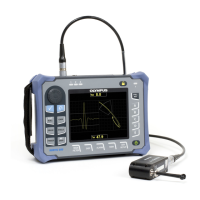DMTA-10040-01EN, Rev. E, February 2018
Using the Instrument 171
The waterfall parameters should not be changed until the PS5 scanner is properly
adjusted following a scan.
12. Set the scanner to the T position (for testing), and then scan the entire hole.
13. Adjust both limit switches so that the probe fully scans the hole and then exits
freely into the air.
To maintain efficient inspection productivity, try to minimize the “air travel” time
outside the hole.
After the PS5 scanner is operating satisfactorily, you will be able to set the
waterfall parameters for a full waterfall display of the inspected hole.
The best results are obtained when the W END (D key) parameter is set to cover
an entire scanning motion.
14. Adjust the W END parameter to cover an entire scanning motion:
a) With the probe positioned at either end of the hole, press the E button on the
PS5 scanner, and then press the motor switch and scan the entire hole.
Closely observe the waterfall display and, if necessary, increase the W END
value (D key) if the waterfall display has been cut off, erased, or refreshed
before the scan is terminated.
b) When the probe reaches the other end of the hole, press the E key on the
scanner, and then scan the entire hole again.
Closely observe the waterfall display to check if a cut-off or incomplete scan
display occurs. If so, decrease the W END value (D key).
c) Repeat steps a–b until you find the right balance between two successive,
complete scans (in both directions) to fully produce two waterfall displays.
15. When the waterfall display is correct, set the W CURSOR (E key) [waterfall
cursor] to the estimated location of the boundary between two critical layers, and
adjust the W CURSOR while you continue complete scanning motions (see
Figure 5-69 on page 172).
After it is properly adjusted, the waterfall cursor is very useful in helping locate a
defect’s position both above and below the critical layer, and it can be used to
decide if a flaw should be accepted or rejected.

